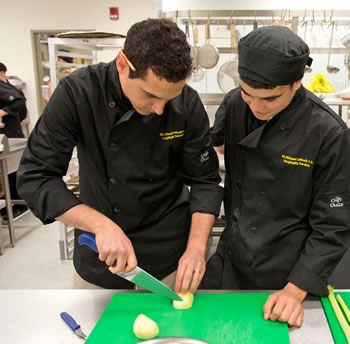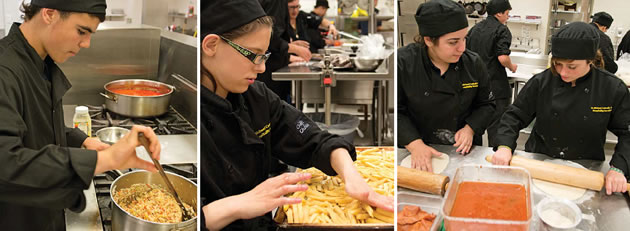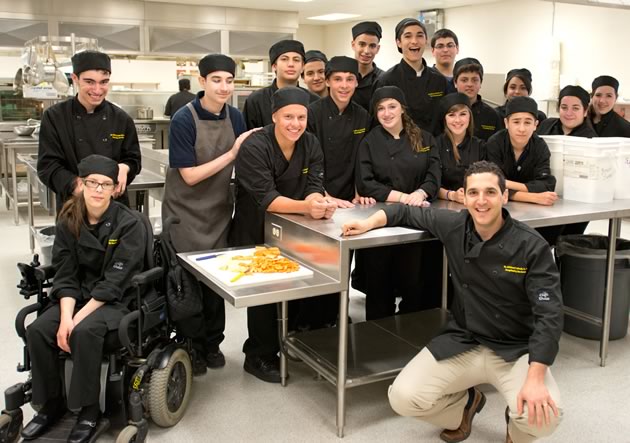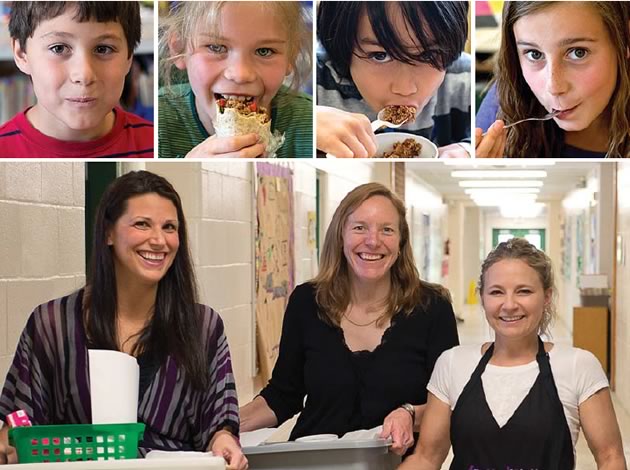Reading, writing and … roasted ribs?
At Bolton’s St. Michael Secondary School, the hickory stick has been replaced with a baguette, and Chef Gallo is calling the tune.
“You must be our visitor,” says Grade 10 student Liam McLaughlin, walking through the office door at St. Michael Catholic Secondary School in Bolton. Neatly dressed in black chef’s garb, he looks me straight in the eye, shakes my hand with a grin, then points the way to his classroom. Such poise. Remarkable for a 16 year old, I think. Then I meet Liam’s classmates.
Even as they chop, stir, and scurry between stations in this state-of-the-art professional kitchen, the students in St. Michael’s busy hospitality and tourism program emanate an uncommon confidence. The vibe here is palpable – clearly these kids feel part of something important, partly because the school’s brand new banquet facility rivals top hotels in the GTA, and partly because they work with a professional caterer to feed the entire school population every day. But mostly these students seem to have found a deep sense of purpose in their work with food.

Chef/teacher Michael Gallo demonstrates knife skills with Christopher Sciamarella. Photo by Pete Paterson.
“Food is life,” says chef/teacher Michael Gallo, 29. He reaches between two students preparing fresh pasta and shows them how to shape a pile of flour to hold a raw egg. “Food starts with elements perfect and whole, and if you approach it with passion, gratitude, creativity and care, you can make something truly magical out of it.” This is Gallo’s credo, and his program is just one shining example of how schools in the Headwaters region are connecting kids to food in ways that can change lives.
It’s not just that new provincial nutritional guidelines for food sold in schools reflect an increased awareness of how high-quality fresh food is key to growing minds and bodies. Yes, the new standards for sugar, carbs, fats, and sodium are a first step in combatting obesity and a variety of attention and behavioural issues. But they don’t come close to the vision of this homegrown Jamie Oliver.
A graduate of Humber College’s prestigious chefs’ school, Gallo took his stagiaire (internship) at chef Andrew Fairlie’s two-Michelin-starred restaurant at the Gleneagles Hotel in Scotland. He returned to Canada with offers from some of Toronto’s top hotels and restaurants. Industry peers expected the Bolton native to open his own restaurant in Toronto or New York. But Gallo’s abiding passion for food remained deeply rooted in Bolton. It was here, growing up in a first-generation Italian-Canadian home, that his love of family, community and home cooking were inexorably linked. But it was his wife Josie and her passion for her work as a teacher that brought Gallo home.

Left to right : Christopher Sciamarella, Alexandra Terisigni, Vanessa Gutta, Alexandra Rebelo: Meeting the demands of mass food production. Photos by Pete Paterson.
“Josie’s stories about her students inspired me,” says Gallo. “I’d pretty much gone to the top of my game, but I knew the greatest reward for me would be giving back to my community. I wanted to pass onto these kids all the amazing things that inspired me to become a chef.”
Fate smiled. St. Michael needed a champion for its new hospitality program. Gallo started last September, and now the program is operating at full capacity of 200 students to rave reviews.
“Michael really engages students with his passion for culinary arts,” says Antonio Rosa, head of the technological studies department at St. Michael. “He’s generating candidates for top chef schools, but the respect he commands and his high expectations also do wonders for at-risk students who really enjoy the energized hands-on learning.”
The hospitality and tourism program combines culinary skills focusing on fresh, healthy foods with a commercial kitchen environment where students must meet the demands of mass food production. They also work front and back of house for their popular staff bistro. The goal is to prepare top graduates for work in the catering industry or post-secondary chef school. And if this year’s final project for the Grade 10 class is any indication, they’ll be ready.
At a Titanic-themed dinner theatre event held at the school last spring, Gallo’s students planned the menu, prepared the food, and served dinner to 200 guests. The entrée was New York strip loin. For dessert, they created an eight-foot-long cake in the shape of the ill-fated vessel. “I can’t tell you the number of people who remarked how professional the catering was,” says Rosa.
With his rookie year now complete and the program’s first Grade 11 class in the wings for this fall, Gallo is focusing on his next steps. He’s reached out to local farmers and community gardens. “Our connection to local food sources is something special in our region,” says Gallo. “Now I want to bring that into our kitchen.”

Back row, left to right : Paul Rubino, Michael Marriani, Noah Marrano, Daniel Rojas, Matthew Provenzano, Michael Khatib, Roberto Lolli, Christopher Scricca, Samantha Simone, Vanessa Gutta, Krystina Hnatykiw. Front row, left to right : Alexandra Terisigni, Antonio Murgida, Liam McLaughlin, Alexandra Rebelo, Alysha Muir, Peter Gonzalez. In front of table : Michael Gallo. Photo by Pete Paterson.
The value of kids connecting with food at its source is something veteran geography teacher Jamie Richards at Orangeville District Secondary School (ODSS) understands well. ODSS was one of the first secondary schools in Ontario to initiate a culinary arts program, and Richards was involved from the start.
His self-sustaining greenhouse program includes cultivating and selling fresh produce such as beans, peas, lettuce, fennel, cabbage, beats, Swiss chard and more to staff and the very popular student-run cafeteria. If you’re not lined up five minutes after the lunch bell, you’ll miss out. Carrots picked in the morning can end up in a chicken pot pie by lunch. A fresh kohlrabi at 9 a.m. might be mango-kohlrabi slaw by noon. Students grow and prepare foods, some they may have never seen before, and their peers throughout the school are eager to savour the fresh new flavours.
Call it a sensory object lesson for what Richards’ students learn in class. “We were just talking about different forms of agriculture, like factory-farmed chickens versus free-range,” he says. Richards brought in both kinds of eggs, the latter from his own farm. The kids then cooked and ate them in class. “They were blown away by the difference in flavour.”
His goal: “If the greenhouse program inspires kids to have their own little garden at some point in time, we’ll have succeeded in shaping well-rounded citizens who are healthy and can take care of their own food.”
Others are starting even earlier to help local students make the connection between living well and eating well. Belfountain Public School’s eco-focused curriculum has had kids planting and harvesting vegetable gardens for some time. Now their hot lunch program, run by school parent Stacey Fokas of Freshalicious.ca, is helping make that fresh food connection for students even stronger. Fokas’ company co-ordinates fresh hot lunch programs for schools in Caledon, Bolton and Orangeville using local chefs who source as many local foods as possible.
“The best measure of the food quality and taste is the near full participation of school families in the program,” says Belfountain principal Raymond Kaake. Their spring menu included roast pepper bruschetta with chicken, beef stir-fry with basmati rice, penne primavera, and for dessert, Stacey’s cranberry cookies or apple cobbler. Allergy-friendly options include gluten-free, lactose-free, vegetarian and nut-free items.
“The kids talk about it. They love the food, and I notice they’re becoming more aware of local seasonal foods on our menus,” says Fokas. “For me, it’s all about the goodness that comes from fresh food.”

Top : The happy faces of well-fed Belfountain kids. Bottom, left to right : Belfountain parents Katarina Prokosch and Jennifer Schill, and Stacey Fokas of Freshalicious: “Making fresh food connections even stronger.” Photos by Pete Paterson.
Gallo would agree. Back in the kitchen at St. Michael, a student approaches with an outstretched handful of freshly made pizza dough, destined for today’s lunch crowd. Gallo picks it up, considers it side to side, and then pinches it. “Perfect, absolutely perfect.” He turns to me and suggests, “You try.” I do. Then he hands it back with a proud smile. “Really perfect,” he insists again as the student leaves beaming. He continues, “I guess what I hope to impart here is what I call a Michelin-starred life. Every little thing you cut, every little thing you plate, means something. It’s really the same passion and care that we should bring to every aspect of life.”






